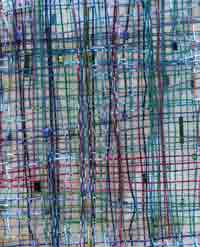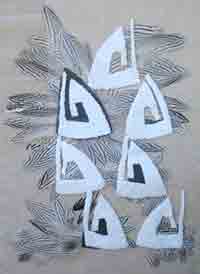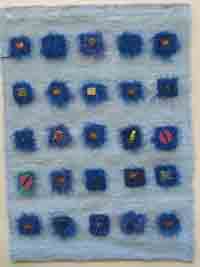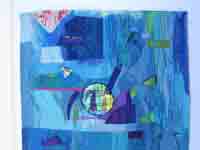 A
luminescent circle gleams over an ocean of subtle fabric waves.
Little squares of small purple beads sit like boats on a pale-blue
sea. Surprising fragments of red and white texture enter from the
side. A cloaked green figure seems to walk along the shore to a
blue-misted house in the distance. Behind in the sky, cloud forms
repeat the patterns on the surface of the water. Little gold amulets
shine in the light. One can feel the coolness in the air and the
breeze rising up from the water.
A
luminescent circle gleams over an ocean of subtle fabric waves.
Little squares of small purple beads sit like boats on a pale-blue
sea. Surprising fragments of red and white texture enter from the
side. A cloaked green figure seems to walk along the shore to a
blue-misted house in the distance. Behind in the sky, cloud forms
repeat the patterns on the surface of the water. Little gold amulets
shine in the light. One can feel the coolness in the air and the
breeze rising up from the water.
This opulent blend of textiles and glass is called Past Meridian, one of 20 fabric constructions in the current show of Rowen Schussheim-Anderson at Artswork Gallery in Le Claire, Iowa. Her exhibit continues to the end of October. (The venue also sponsors this reviewer's weekly radio program, Art Talks, on WVIK.)
Schussheim-Anderson has created tapestries of astonishing visual beauty. Her sensitivity to pattern, texture, and color has formed the objects, but it's a vision both ancient and modern that enriches us.
The artist has taught fabric and textiles in the Augustana College Art Department for more than 25 years. Widely traveled in South America, Africa, and the southwestern United States to study native artists in their studios, Rowen has absorbed traditional weaving techniques. Working in the same medium, she has added a new voice to the older ones with her play of images and materials.
 When
I visited her studio and watched her work, she said her technique
begins with a colored-pencil sketch. From this she begins her weaving
and beading. In the process, she adds and subtracts elements, until a
further idea emerges. Her decisions while working are based on how
the color and texture will look in the piece; the title and meaning
come later. The artist is constantly working on several pieces at a
time - in the car, at school, and at home. Parts may drift from one
fabric assembly to another; some are never used.
When
I visited her studio and watched her work, she said her technique
begins with a colored-pencil sketch. From this she begins her weaving
and beading. In the process, she adds and subtracts elements, until a
further idea emerges. Her decisions while working are based on how
the color and texture will look in the piece; the title and meaning
come later. The artist is constantly working on several pieces at a
time - in the car, at school, and at home. Parts may drift from one
fabric assembly to another; some are never used.
Schussheim-Anderson's fabric pieces are intricately woven with thick and rich surfaces, in startling and pleasing color combinations. Working in a collage manner, she uses both realistic and rounded geometric forms, which inevitably suggest a meaning to the viewer. Inside each area of fabric, inside each element of design, are areas of great charm and color.
Some of her fabric collages repeat similar forms. Grid Locket contains 25 small, fluffy blue bursts of thin crocheted fabric. They are placed evenly in garden rows over the surface of a rustic blue-and-white woven background fabric. In all but two are discovered little beaded works of opalescent glass sewn onto the fabric, sitting like an egg in a nest. (Julie Whitlatch from Cedar Rapids often supplies the glass pieces.)
 In
arch i structure,
textured fabric squares sit on a pale turquoise background of woven
fabric. On the right, a light green path climbs slowly up a terraced
hill. Swaying red branches hover by the side, and behind them small
windows of soft purple and white appear in the evening sky. Although
consisting of mostly abstract linear and geometric forms, these are
read as a remembered place, loosely described and evocative,
translated now into a creation that we can actually touch.
In
arch i structure,
textured fabric squares sit on a pale turquoise background of woven
fabric. On the right, a light green path climbs slowly up a terraced
hill. Swaying red branches hover by the side, and behind them small
windows of soft purple and white appear in the evening sky. Although
consisting of mostly abstract linear and geometric forms, these are
read as a remembered place, loosely described and evocative,
translated now into a creation that we can actually touch.
A more modern use of weaving techniques, fiberglas 1 is constructed of long strands of weft and warp with great spaces left open in between, allowing the wall to show through or the air to pass through. With a foundation network of rabbit fence from the hardware store, along with other wires wrapped in colored thread, the whole flowing grid is interspersed with squares and small rectangles of bright glimmering glass. The piece is reminiscent of the silence and space between words, between the flows of tides, between relationships. I sense a description of experiences suspended in a field of time.
There is a feeling of storytelling that comes out of Schussheim-Anderson's work. Much of this comes from the ancient medium of weaving itself and the elemental associations it stirs, but part stems from her awareness and experience of many cultures, including our own. What these images tell is the story of nature and the patterns of life, repeated in time like the recurring journey of the shuttle through the threads. Even the Greeks believed that a person's life was a thread on a weaving, ending when cut by one of the blind Muses of mythology.
 Lineage
seems like an airplane-viewed city, surrounded by a countryside of
soft, fertile colors. Large areas of turquoise and grays surround a
beaded rounded form with roads of bright red thread cutting through.
Rowed fields of beads in dim reds, shy yellows, sparkling blues, and
subtle violets radiate out from each area, describing sections.
Lineage
seems like an airplane-viewed city, surrounded by a countryside of
soft, fertile colors. Large areas of turquoise and grays surround a
beaded rounded form with roads of bright red thread cutting through.
Rowed fields of beads in dim reds, shy yellows, sparkling blues, and
subtle violets radiate out from each area, describing sections.
First Flight is a calm image whose forms were originally inspired by Navajo pottery designs from the collection of the Augustana College library. Seven triangular shapes, floating lightly on a sea of light-gray fabric, and heavily beaded in white and black, are surrounded by wings of gray- and white-striped feathers. The effect is like watching a fleet of sailboats in the morning. The title may refer to birds in first flight, or boats on a maiden voyage, or even children in their first journey away from home.
Sesefun, meaning "blue" in an African language, consists of long entangled threads of dark-blue yarn cascading to a waterfall of foaming thick blue threads at the bottom. Little sparkles of glass appear to cut across the midst of the long strands. Rough fabric and smooth glass carry little parcels of beadwork swirling into the deluge.
The exhibit deftly shows that Rowen Schussheim-Anderson is an elegant artist of enriching vision who has mastered her timeless medium.
A reception for and demonstration by the artist will be held on Saturday, October 13, from 4 to 5 p.m. The Artswork gallery, located at 221 North Cody Road in Le Claire, is open from 10 a.m. to 5 p.m. Monday through Saturday, and from noon to 5 p.m. on Sunday.










